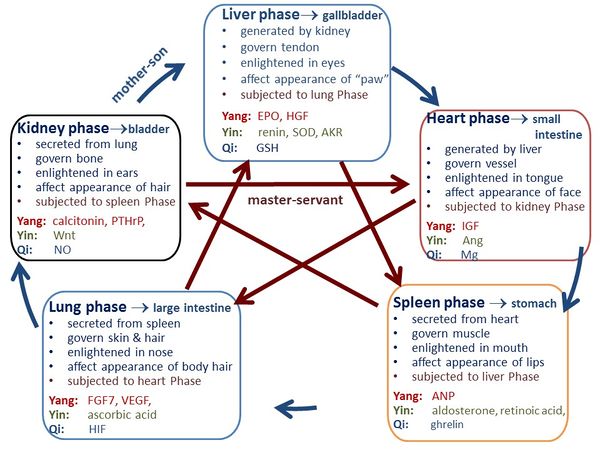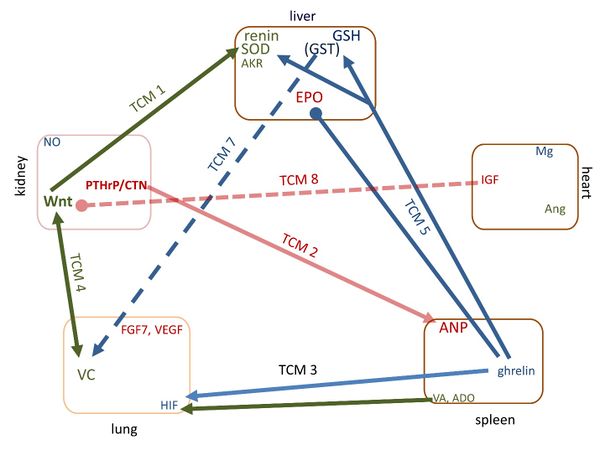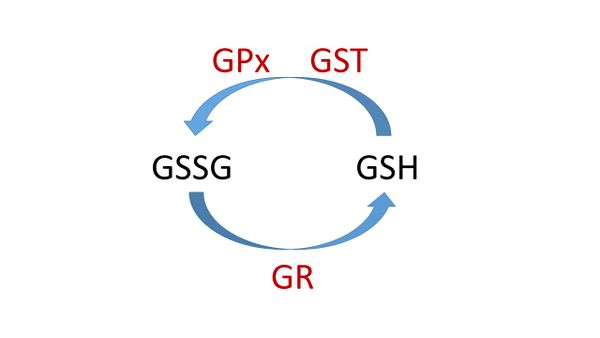Consistence between the eight treating principles of traditional Chinese medicine and molecular signaling
Authors: Yang LIU*
Affiliations:
The Hong Kong Polytechnic University, Hung Hom, Kowloon, Hong Kong.
- To whom correspondence should be addressed: mmyliu@polyu.edu.hk
Abstract
Traditional Chinese medicine (TCM) continues to provide pharmacotherapy for millions of people worldwide, but one of the challenges before accepted by the “Western” medicine is the elucidation of its molecular mechanism. Traditional Chinese medicine (TCM) used Yang–Yin-Qi in heart-spleen-lung-kidney-liver to describe the physiological processes and developed therapeutic strategies based on the interrelationships among the Yang-Yin-Qi in these five organs. Here we established the direct mapping between Yang-Yin-Qi and signaling molecules based on their physiological functions. We compared the eight popular TCM treatment principles with pathways of signaling molecules, and found an excellent agreement. The results show that Western medicine and TCM describe the same physiological process using different terminology.
Key words: Signaling molecules, traditional Chinese medicine, pathways, Yang and Yin, therapeutic strategy.
Glossary
| AKR | aldo-keto reductase, Liver Yin in TCM |
| Ang | Angiotensin, Heart Yin in TCM |
| ANP | atrial natriuretic peptide, Spleen Yang in TCM |
| EPO | Erythropoietin, Liver Yang in TCM |
| FGF7 | fibroblast growth factor-7, Lung Yang in TCM |
| Five Phases | TCM term, includes heart phase, spleen phase, lung phase, kidney phase, liver phase |
| GSH | Glutathione, Liver Qi in TCM |
| Heart phase | TCM term, includes heart organ, Heart Yang, Heart Yin, and Heart Qi |
| HGF | hepatocyte growth factor, Liver Yang in TCM |
| HIF | hypoxia inducible factor, Lung Qi in TCM |
| IGF | insulin-like growth factor, Heart Yang in TCM |
| Kidney phase | TCM term, includes kidney organ, Kidney Yang, Kidney Yin, and Kidney Qi |
| Liver phase | TCM term, includes liver organ, Liver Yang, Liver Yin, and Liver Qi |
| Lung phase | TCM term, includes lung organ, Lung Yang, Lung Yin, and Lung Qi |
| Mg | Magnesium, Heart Qi in TCM |
| NO | nitric oxide, Kidney Qi in TCM |
| PTHrP | parathyroid hormone-related protein, Kidney Yin in TCM |
| Qi | substance in TCM, has function of activation and regulation |
| SOD | superoxide dismutase, Liver Yin in TCM |
| Spleen phase | TCM term, includes spleen organ, Spleen Yang, Spleen Yin, and Spleen Qi |
| TCM | traditional Chinese medicine |
| VEGF | vascular endothelial growth factor, Lung Yang in TCM |
| Yang | Key substance in TCM, has function of warming/developing/proliferation |
| YEIC | Yellow Emperor’s Inner Canon |
| Yin | Key substance in TCM, has function of cooling and astringent |
1. Introduction
Although traditional Chinese medicine (TCM) provides fertile ground for modern drug development, the path from TCM to Western pharmaceutical is fraught with challenges, and one of the greatest challenges is the elucidation of its molecular mechanism [1]. To thoroughly utilize this rich resource, we need to understand the molecular mechanism of TCM theory first.
Ancient TCM physicians believed that there existed key substances to regulate the physiological processes and named them as Yang, Yin and Qi, where Yang has warming/developing function, Yin has cooling/astringent function, and Qi has actuating/regulating function. Yang and Yin are contrary but interdependent in human body. According to the physiological functions of these key substances, ancient TCM physicians categorized these Yang-Yin-Qi into heart phase, spleen phase, lung phase, kidney phase and liver phase, i.e., the Five Phases. According to “Yellow Emperor’s Inner Canon” (YEIC) [2], the fundamental doctrinal source for TCM, each organ phase has particular physiological functions, and the Five Phases regulate each other and follow the “mother-son” and “master-servant” relationships (Figure 1). TCM physicians developed diagnosis theories and therapeutic strategies based on these interrelationships, and particularly there are eight most popular treatment principles [3].
Using the iterative selection method, we established the direct mapping between these Yang-Yin and signaling molecules[4, 5]. Here we further prove that the eight TCM popular treatment principles are highly consistent with the pathways of signaling molecules.
2. Results
2.2 The consistency between pathways of signaling molecules and eight TCM treatment principles
As shown in Figure 1, TCM considers that, along the outer circle, the five phases follow the “mother-son” (assisting) relationships; and long the diagonal direction, the five phases follow the “master-servant” (regulating) relationships. Based on these relationships, TCM developed eight popular treatment principles [3]. We compared these eight treatment principles with the pathways of corresponding signaling molecules, and found that these eight principles precisely described the molecular signaling, as shown in Figure 2.
The first TCM treatment principle is “replenishing kidney Yin then replenishing liver Yin” which is usually used for kidney Yin deficiency and liver Yin insufficiency [3]. In physiological reality, the up-regulation of Wnt/β-catenin signaling is associated with the recovery of SOD levels [6], Wnt/β-catenin is the master regulator that controls multiple renin-angiotensin system genes [7], and SOD1 overexpression can restore impaired Wnt signaling [8], indicating that the Wnt (kidney Yin molecule) and renin/SOD (liver Yin molecules) are assisting each other. Therefore, this TCM method describes accurately the relationship of molecular signaling.
The second TCM treatment principle is “warming kidney Yang to replenish spleen Yang” which is used for declined kidney Yang induced weak spleen Yang [3]. In physiological reality, calcitonin gene-related peptide (CGRP) stimulates ANP secretion [9], indicating that increasing CGRP (kidney Yang related molecule) would stimulates ANP (spleen Yang molecule).
The third TCM treatment principle is “strengthening spleen to replenish lung Qi” which is used for declined spleen Qi induced lung Qi debility [3]. In physiological reality, HIF-1α and VEGF mRNAs are significantly increased after ghrelin administration [10], and retinoic acid increases HIF-1α [11]. Therefore, increasing ghrelin (spleen Qi molecule) and retinoic acid (spleen Yin molecule) could enhance HIF (lung Qi molecule).
The fourth TCM treatment principle is “lung Yin and kidney Yin assisting each other” which is used for the cases of deficient kidney Yin induced lung Yin deficiency, or deficient lung Yin induced kidney Yin deficiency[3]. In physiological reality, Wnt regulates vitamin C biosynthesis [12]; treatment with ascorbic acid treatment can improve the effect of Wnt signaling [13], indicating that Wnt (kidney Yin molecule) and ascorbic acid (lung Yin molecule) assist each other.
The fifth TCM treatment principle is “invigorating spleen and dredging liver” [3]. Liver Qi molecule is glutathione which exists in both reduced GSH and oxidized GSSG states. As shown in Figure 3, in the glutathione redox cycle, GSH is converted by glutathione peroxide (GPx) to GSSG; GSH can be regenerated from GSSG by the enzyme glutathione reductase (GR). Mitochondrial Glutathione-S-transferases (GSTs) display both GSH transferase and peroxidase activities that detoxify harmful byproducts through GSH conjugation or GSH-mediated peroxide reduction [14]. In physiological reality, ghrelin treatment can decrease plasma EPO and EPO gene expression in the hypoxic rats [15], and increase SOD, GPx, GST, GR and GSH [16, 17], indicating ghrelin treatment (spleen Qi molecule) can enhance the glutathione redox cycle, i.e., dredge liver.
The sixth TCM treatment principle is “invigorating spleen for diuresis (reducing edema)” [3]. In physiological reality, ghrelin (spleen Qi molecule) promotes diuresis [18, 19], administration of ghrelin may be useful in reducing brain edema induced by acute systemic hypoxia [20], increased levels of aldosterone (spleen Yin molecule) are able to maintain sodium balance and avoid an edematous state [21], and 9-cis retinoic acid (spleen Yin molecule) could significantly prevent postsurgical lymphedema [22].
The seventh TCM treatment principle is “replenishing lung Yin and cleansing liver” [3]. In physiological reality, GST has the ability to catalyze the conjugation of GSH to xenobiotic substrates for the purpose of detoxification; GST improves the serum ascorbic acid response to vitamin C intake [23], and GST enzymes protect against serum ascorbic acid deficiency when dietary vitamin C is insufficient [24]. This indicates that “detoxification” (cleansing liver) improves the serum ascorbic acid response (lung Yin).
The eighth TCM treatment principle is “reducing heart Yang to replenish kidney Yin” which is used for vigorous heart Yang induced kidney Yin deficiency [3]. In physiological reality, IGF signaling antagonizes the Wnt pathway [25], i.e., one should decrease IGF (heart Yang) for increasing Wnt signaling (kidney Yin).
Therefore, the eight classic TCM treatment principles are highly consistent with the pathways of corresponding signaling molecules.
The direct mapping between TCM and signaling molecules enables us to understand TCM thoroughly that would lead to tremendous Western “discoveries” of traditional medicines [1].
Table 1 Corresponding signaling molecules of each organ phase
| Yang | Yin | Qi | |
| Heart phase | IGF | Ang | Mg |
| Spleen phase | ANP | aldosterone,
retinoic acid |
ghrelin |
| Lung phase | FGF7, VEGF | ascorbic acid | HIF |
| Kidney phase | calcitonin, PTHrP | Wnt | NO |
| Liver phase | EPO, HGF | renin, SOD, AKR | GSH |
Figure Legends
Figure 1. The functions and interrelationships of the Five Phases in TCM. The Heart phase should be generated in liver, govern blood vessel, and be enlightened in tongue; and its prosperity is reflected by face. The Spleen phase should be generated in heart, govern muscle, and be enlightened in mouth; and its prosperity is reflected by lips. The Lung phase should be secreted in spleen, govern skin and hair, and be enlightened in nose; and its prosperity is reflected in body hair. The Kidney phase should be generated in lung, govern bone, be enlightened in ears, and affect the appearance of hair. The Liver phase should be generated in kidney, govern tendon, be enlightened in eyes, and affect the appearance of “paw” (finger, toe, nail). Furthermore, Heart phase is connected with small intestine, Spleen phase is connected with stomach, Lung phase is connected with large intestine, Kidney phase is connected with bladder, and Liver phase is connected with gallbladder. The arrow along outer circle denotes the “mother-son” relationship, and the arrow along the diagonal direction indicates the “master-servant” relationship.
Figure 2. The consistence between eight TCM treatment principles and pathways of signaling molecules. TCM 1: replenishing kidney Yin then replenishing liver Yin; TCM 2: warming kidney Yang to replenish spleen Yang; TCM 3: strengthening spleen to replenish lung Qi; TCM 4: lung Yin and kidney Yin assisting each other; TCM 5: invigorating spleen and dredging liver; TCM 7: replenishing lung Yin and cleansing liver; TCM 8: reducing heart Yang to replenish kidney Yin. Arrow indicates increasing, and solid circle indicates decreasing.
Figure 3. The glutathione redox cycle. GSH is the reduced state and GSSG (glutathione disulfide) is the oxidized state. GSH is converted by glutathione peroxide (GPx) to GSSG; GSH can be regenerated from GSSG by the enzyme glutathione reductase (GR). Glutathione-S-transferase (GST) GST can catalyze the conjugation of GSH for detoxification.
Figure 1. The functions and interrelationships of the Five Phases in TCM. The Heart phase should be generated in liver, govern blood vessel, and be enlightened in tongue; and its prosperity is reflected by face. The Spleen phase should be generated in heart, govern muscle, and be enlightened in mouth; and its prosperity is reflected by lips. The Lung phase should be secreted in spleen, govern skin and hair, and be enlightened in nose; and its prosperity is reflected in body hair. The Kidney phase should be generated in lung, govern bone, be enlightened in ears, and affect the appearance of hair. The Liver phase should be generated in kidney, govern tendon, be enlightened in eyes, and affect the appearance of “paw” (finger, toe, nail). Furthermore, Heart phase is connected with small intestine, Spleen phase is connected with stomach, Lung phase is connected with large intestine, Kidney phase is connected with bladder, and Liver phase is connected with gallbladder. The arrow along outer circle denotes the “mother-son” relationship, and the arrow along the diagonal direction indicates the “master-servant” relationship.
Figure 2. The consistence between eight TCM treatment principles and pathways of signaling molecules. TCM 1: replenishing kidney Yin then replenishing liver Yin; TCM 2: warming kidney Yang to replenish spleen Yang; TCM 3: strengthening spleen to replenish lung Qi; TCM 4: lung Yin and kidney Yin assisting each other; TCM 5: invigorating spleen and dredging liver; TCM 7: replenishing lung Yin and cleansing liver; TCM 8: reducing heart Yang to replenish kidney Yin. Arrow indicates increasing, and solid circle indicates decreasing.
Figure 3. The glutathione redox cycle. GSH is the reduced state and GSSG (glutathione disulfide) is the oxidized state. GSH is converted by glutathione peroxide (GPx) to GSSG; GSH can be regenerated from GSSG by the enzyme glutathione reductase (GR). Glutathione-S-transferase (GST) GST can catalyze the conjugation of GSH for detoxification.
References
1. Corson, T.W. and C.M. Crews, Molecular understanding and modern application of traditional medicines: triumphs and trials. Cell, 2007. 130(5): p. 769-774.
2. Huang-Di, Huang Di Nei Jing [Yellow Emperor's Inner Canon]. . 2005, Beijing: People's Health Publishing House
3. Sun, G.R., Fundamental Theory of TCM. 2002, Beijing: China Press of TCM.
4. Liu, Y., The closed-loop pathways of signaling molecules. bioRxiv, 2017: p. 129841.
5. Y., L., Traditional Chinese medicine describes the pathways of signaling molecules. Traditional Chinese Medicine and Molecular Signaling, 2017.
6. Yang, Y.Y., et al., Involvement of the HIF-1 alpha and Wnt/beta-catenin pathways in the protective effects of losartan on fatty liver graft with ischaemia/reperfusion injury. Clinical Science, 2014. 126(1-2): p. 163-174.
7. Zhou, L. and Y. Liu, Wnt/β-catenin signaling and renin–angiotensin system in chronic kidney disease. Current opinion in nephrology and hypertension, 2016. 25(2): p. 100-106.
8. Wang, F., et al., Superoxide dismutase 1 in vivo ameliorates maternal diabetes-induced apoptosis and heart defects through restoration of impaired Wnt signaling. Circulation: Cardiovascular Genetics, 2015: p. CIRCGENETICS. 115.001138.
9. Yamamoto, A., et al., Calcitonin Gene-Related Peptide (Cgrp) Stimulates the Release of Atrial Natriuretic Peptide(Anp) from Isolated Rat Atria. Biochemical and Biophysical Research Communications, 1988. 155(3): p. 1452-1458.
10. Konturek, P.C., et al., Ghrelin-induced gastroprotection against ischemia-reperfusion injury involves an activation of sensory afferent nerves and hyperemia mediated by nitric oxide. European Journal of Pharmacology, 2006. 536(1-2): p. 171-181.
11. Fernandez-Martinez, A.B., M.I.A. Jimenez, and F.J.L. Cazana, Retinoic acid increases hypoxia-inducible factor-1 alpha through intracrine prostaglandin E-2 signaling in human renal proximal tubular cells HK-2. Biochimica Et Biophysica Acta-Molecular and Cell Biology of Lipids, 2012. 1821(4): p. 672-683.
12. Nejak-Bowen, K.N., et al., beta-Catenin Regulates Vitamin C Biosynthesis and Cell Survival in Murine Liver. Journal of Biological Chemistry, 2009. 284(41): p. 28115-28127.
13. Ivanyuk, D., et al., Ascorbic acid-induced cardiac differentiation of murine pluripotent stem cells: transcriptional profiling and effect of a small molecule synergist of Wnt/β-catenin signaling pathway. Cellular Physiology and Biochemistry, 2015. 36(2): p. 810-830.
14. Ribas, V., C. García-Ruiz, and J.C. Fernández-Checa, Glutathione and mitochondria. 2014.
15. Feizi, H., et al., Effect of ghrelin on renal erythropoietin production in chronic hypoxic rats. Endocrine regulations, 2014. 48(1): p. 3-8.
16. Dobutovic, B., et al., Effects of ghrelin on protein expression of antioxidative enzymes and iNOS in the rat liver. Arch Med Sci, 2014. 10(4): p. 806-816.
17. Karatug, A., et al., Regulation of gene expression and biochemical changes in small intestine of newborn diabetic rats by exogenous ghrelin. Peptides, 2012. 33(1): p. 101-108.
18. Mao, Y., T. Tokudome, and I. Kishimoto, Ghrelin and Blood Pressure Regulation. Current hypertension reports, 2016. 18(2): p. 1-6.
19. Aoki, H., et al., Ghrelin counteracts salt-induced hypertension via promoting diuresis and renal nitric oxide production in Dahl rats. Endocrine journal, 2013. 60(5): p. 571-581.
20. Hossienzadeh, F., et al., Effect of ghrelin on brain edema induced by acute and chronic systemic hypoxia. Neuroscience letters, 2013. 534: p. 47-51.
21. Prakash, E.S., “Aldosterone escape” or refractory hyperaldosteronism? Medscape General Medicine, 2005. 7(3): p. 25.
22. Bramos, A., et al., Prevention of Postsurgical Lymphedema by 9-cis Retinoic Acid. Annals of surgery, 2016. 264(2): p. 353-361.
23. Cahill, L., B. Fontaine-Bisson, and A. El-Sohemy, Glutathione S-transferase gene polymorphisms and vitamin C. The FASEB Journal, 2009. 23(1 Supplement): p. 725.1-725.1.
24. Cahill, L.E., B. Fontaine-Bisson, and A. El-Sohemy, Functional genetic variants of glutathione S-transferase protect against serum ascorbic acid deficiency. The American journal of clinical nutrition, 2009. 90(5): p. 1411-1417.
25. Schlupf, J. and H. Steinbeisser, IGF antagonizes the Wnt/beta-Catenin pathway and promotes differentiation of extra-embryonic endoderm. Differentiation, 2014. 87(5): p. 209-219.
Document information
Published on 30/06/17
Submitted on 30/06/17
Licence: CC BY-NC-SA license
Share this document
claim authorship
Are you one of the authors of this document?


